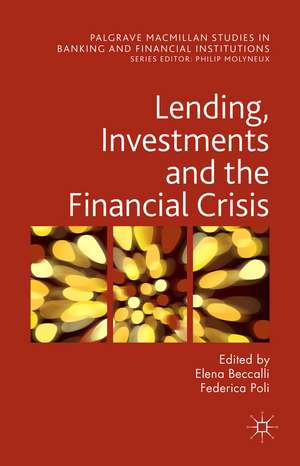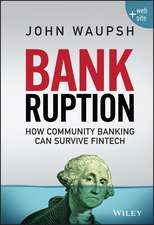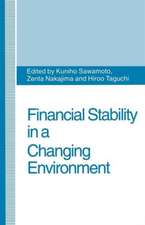Lending, Investments and the Financial Crisis: Palgrave Macmillan Studies in Banking and Financial Institutions
Editat de Elena Beccalli, Federica Polien Limba Engleză Hardback – 17 aug 2015
Din seria Palgrave Macmillan Studies in Banking and Financial Institutions
- 9%
 Preț: 1028.24 lei
Preț: 1028.24 lei - 17%
 Preț: 359.43 lei
Preț: 359.43 lei - 9%
 Preț: 907.70 lei
Preț: 907.70 lei - 15%
 Preț: 694.04 lei
Preț: 694.04 lei - 15%
 Preț: 638.43 lei
Preț: 638.43 lei - 15%
 Preț: 643.34 lei
Preț: 643.34 lei -
 Preț: 389.11 lei
Preț: 389.11 lei - 15%
 Preț: 669.97 lei
Preț: 669.97 lei - 15%
 Preț: 642.51 lei
Preț: 642.51 lei - 15%
 Preț: 642.51 lei
Preț: 642.51 lei - 15%
 Preț: 649.06 lei
Preț: 649.06 lei - 15%
 Preț: 639.25 lei
Preț: 639.25 lei - 15%
 Preț: 640.06 lei
Preț: 640.06 lei - 18%
 Preț: 752.88 lei
Preț: 752.88 lei - 15%
 Preț: 640.06 lei
Preț: 640.06 lei - 15%
 Preț: 645.47 lei
Preț: 645.47 lei - 18%
 Preț: 889.75 lei
Preț: 889.75 lei - 15%
 Preț: 641.20 lei
Preț: 641.20 lei -
 Preț: 386.39 lei
Preț: 386.39 lei - 15%
 Preț: 643.34 lei
Preț: 643.34 lei -
 Preț: 388.72 lei
Preț: 388.72 lei -
 Preț: 396.40 lei
Preț: 396.40 lei - 15%
 Preț: 642.51 lei
Preț: 642.51 lei - 15%
 Preț: 638.76 lei
Preț: 638.76 lei - 15%
 Preț: 639.73 lei
Preț: 639.73 lei - 15%
 Preț: 637.59 lei
Preț: 637.59 lei -
 Preț: 387.75 lei
Preț: 387.75 lei - 15%
 Preț: 641.20 lei
Preț: 641.20 lei - 15%
 Preț: 640.88 lei
Preț: 640.88 lei -
 Preț: 389.70 lei
Preț: 389.70 lei - 15%
 Preț: 648.24 lei
Preț: 648.24 lei - 15%
 Preț: 638.43 lei
Preț: 638.43 lei - 15%
 Preț: 641.20 lei
Preț: 641.20 lei - 15%
 Preț: 638.76 lei
Preț: 638.76 lei -
 Preț: 391.61 lei
Preț: 391.61 lei - 15%
 Preț: 641.20 lei
Preț: 641.20 lei - 15%
 Preț: 643.34 lei
Preț: 643.34 lei - 15%
 Preț: 641.71 lei
Preț: 641.71 lei -
 Preț: 390.63 lei
Preț: 390.63 lei - 15%
 Preț: 641.71 lei
Preț: 641.71 lei - 15%
 Preț: 644.95 lei
Preț: 644.95 lei - 15%
 Preț: 645.79 lei
Preț: 645.79 lei - 15%
 Preț: 645.79 lei
Preț: 645.79 lei - 15%
 Preț: 638.76 lei
Preț: 638.76 lei - 15%
 Preț: 640.06 lei
Preț: 640.06 lei - 15%
 Preț: 640.06 lei
Preț: 640.06 lei - 15%
 Preț: 643.34 lei
Preț: 643.34 lei - 15%
 Preț: 642.51 lei
Preț: 642.51 lei - 15%
 Preț: 640.06 lei
Preț: 640.06 lei - 18%
 Preț: 1125.86 lei
Preț: 1125.86 lei
Preț: 640.55 lei
Preț vechi: 753.60 lei
-15% Nou
Puncte Express: 961
Preț estimativ în valută:
122.60€ • 127.51$ • 102.74£
122.60€ • 127.51$ • 102.74£
Carte tipărită la comandă
Livrare economică 13-27 martie
Preluare comenzi: 021 569.72.76
Specificații
ISBN-13: 9781137531001
ISBN-10: 1137531002
Pagini: 240
Ilustrații: XX, 215 p.
Dimensiuni: 140 x 216 x 14 mm
Greutate: 0.42 kg
Ediția:1st ed. 2015
Editura: Palgrave Macmillan UK
Colecția Palgrave Macmillan
Seria Palgrave Macmillan Studies in Banking and Financial Institutions
Locul publicării:London, United Kingdom
ISBN-10: 1137531002
Pagini: 240
Ilustrații: XX, 215 p.
Dimensiuni: 140 x 216 x 14 mm
Greutate: 0.42 kg
Ediția:1st ed. 2015
Editura: Palgrave Macmillan UK
Colecția Palgrave Macmillan
Seria Palgrave Macmillan Studies in Banking and Financial Institutions
Locul publicării:London, United Kingdom
Cuprins
List Of Figures
List Of Tables
Preface
Introduction: Lending, Investments And The Financial Crisis: Elena Beccalli And Federica Poli
1. How Difficult Is To Raise Money In Turbulent Times?: Paola Bongini, Arturo Patarnello, Matteo Pelegatti And Monica Rossolini
1.1. Introduction
1.2. Review Of Literature
1.3. Sample Characteristics
1.4. The Cost Of Bonds At Issuance
1.5. Conclusions
2. The '' ''Wisdom Of The Crowd '' '' As An Antidote For The Credit Crunch. A Preliminary Analysis Of The Crowdfunding: Danile Previati, Giuseppe Galloppo And Andrea Salustri
2.1. Introduction: Research Approach And Research Questions
2.2. Crowdfunding Defined: From Policy Orientations To Academic Literature
2.3. Different Kinds Of Crowdfunding And Some Data About Crowdfunding Market
2.4. Crowdfunding Drivers
2.5. Crowdfunding Attractiveness Index
2.6. Crowdfunding Attractiveness Index In The Euro Area
2.7. Summary And Concluding Remarks
3. Financing Firms '' '' Networks: The Italian Case: Elisa Giaretta And Giusy Chesini
3.1. Introduction
3.2. Literature Review
3.3. The Italian Context
3.4. Hypotheses Development Section
3.5. Research Method And Sample Description
3.6. Results
3.7. Conclusions
4. The Role Of Loan Dynamics And Structure For CEE Economic Growth: Ewa Miklaszewska And Katarzyna Mikołajczyk
4.1. Introduction
4.2. The Role Of Credit And Its Structure For Economic Growth
4.3. Role And Factors Influencing Credit For Smes
4.4. Loan Dynamics And Structure In CEE In The Pre- And Post-Crisis Period
4.5. Empirical Analysis: The Regression Model
4.6. Empirical Analysis: Panel Data Model
4.7. Conclusions
5. China '' ''s Shadow Banking System And Its Lurking Credit Crunch: Causes And Policy Options: René W.H. Van Der Linden
5.1. Introduction
5.2. China '' ''s Debt Concerns And Subsequent Policy Responses
5.3. The Nature Of China '' ''s Shadow Banking And A Comparison With ItsWestern Peers
5.4. The Rationale Behind The Rapid Expansion Of China '' ''s Shadow Banking
5.5. The Size And Scope Of China '' ''s Shadow Banking System
5.6. Reasons For And Against A Potential Crisis In The Making
5.7. Preventive And Remedial Policy Measures To Tackle Shadow Banking Risks
5.8. Concluding Remarks And Recommendations
6. An Index Of Bank Liquidity Creation: An Application To The Banking Systems Of The Eurozone And The Liquidity Policy Of The ECB During The Euro Crisis: Pierluigi Morelli, Giovanni B. Pittaluga And Elena Seghezza
6.1. Introduction
6.2. The Theoretical Framework
6.3. The Trend Of The Liquidity Needs Of The Banking Systems Of The Eurozone
6.4. The Way ECB Faced Banks '' '' Liquidity Needs In The Recent Financial Crises
6.5. Conclusions
7. The Performance Of Listed European Innovative Firms: Luisa Anderloni And Alessandra Tanda
7.1. Introduction
7.2. Literature Review
7.3. Sample And Methodology
7.4. Results7.5. Conclusions
8. Investment Strategies Of Institutional Investors: An International Comparison Of Sovereign Pension And Social Security Reserve Funds: Alberto Dreassi, Stefano Miani And Andrea Paltrinieri
8.1. Introduction
8.2. Literature Review And Hypothesis Development
8.3. Data And Methodology
8.4. 4 Discussion Of Findings
8.5. Conclusions And Policy Recommendations
List Of Tables
Preface
Introduction: Lending, Investments And The Financial Crisis: Elena Beccalli And Federica Poli
1. How Difficult Is To Raise Money In Turbulent Times?: Paola Bongini, Arturo Patarnello, Matteo Pelegatti And Monica Rossolini
1.1. Introduction
1.2. Review Of Literature
1.3. Sample Characteristics
1.4. The Cost Of Bonds At Issuance
1.5. Conclusions
2. The '' ''Wisdom Of The Crowd '' '' As An Antidote For The Credit Crunch. A Preliminary Analysis Of The Crowdfunding: Danile Previati, Giuseppe Galloppo And Andrea Salustri
2.1. Introduction: Research Approach And Research Questions
2.2. Crowdfunding Defined: From Policy Orientations To Academic Literature
2.3. Different Kinds Of Crowdfunding And Some Data About Crowdfunding Market
2.4. Crowdfunding Drivers
2.5. Crowdfunding Attractiveness Index
2.6. Crowdfunding Attractiveness Index In The Euro Area
2.7. Summary And Concluding Remarks
3. Financing Firms '' '' Networks: The Italian Case: Elisa Giaretta And Giusy Chesini
3.1. Introduction
3.2. Literature Review
3.3. The Italian Context
3.4. Hypotheses Development Section
3.5. Research Method And Sample Description
3.6. Results
3.7. Conclusions
4. The Role Of Loan Dynamics And Structure For CEE Economic Growth: Ewa Miklaszewska And Katarzyna Mikołajczyk
4.1. Introduction
4.2. The Role Of Credit And Its Structure For Economic Growth
4.3. Role And Factors Influencing Credit For Smes
4.4. Loan Dynamics And Structure In CEE In The Pre- And Post-Crisis Period
4.5. Empirical Analysis: The Regression Model
4.6. Empirical Analysis: Panel Data Model
4.7. Conclusions
5. China '' ''s Shadow Banking System And Its Lurking Credit Crunch: Causes And Policy Options: René W.H. Van Der Linden
5.1. Introduction
5.2. China '' ''s Debt Concerns And Subsequent Policy Responses
5.3. The Nature Of China '' ''s Shadow Banking And A Comparison With ItsWestern Peers
5.4. The Rationale Behind The Rapid Expansion Of China '' ''s Shadow Banking
5.5. The Size And Scope Of China '' ''s Shadow Banking System
5.6. Reasons For And Against A Potential Crisis In The Making
5.7. Preventive And Remedial Policy Measures To Tackle Shadow Banking Risks
5.8. Concluding Remarks And Recommendations
6. An Index Of Bank Liquidity Creation: An Application To The Banking Systems Of The Eurozone And The Liquidity Policy Of The ECB During The Euro Crisis: Pierluigi Morelli, Giovanni B. Pittaluga And Elena Seghezza
6.1. Introduction
6.2. The Theoretical Framework
6.3. The Trend Of The Liquidity Needs Of The Banking Systems Of The Eurozone
6.4. The Way ECB Faced Banks '' '' Liquidity Needs In The Recent Financial Crises
6.5. Conclusions
7. The Performance Of Listed European Innovative Firms: Luisa Anderloni And Alessandra Tanda
7.1. Introduction
7.2. Literature Review
7.3. Sample And Methodology
7.4. Results7.5. Conclusions
8. Investment Strategies Of Institutional Investors: An International Comparison Of Sovereign Pension And Social Security Reserve Funds: Alberto Dreassi, Stefano Miani And Andrea Paltrinieri
8.1. Introduction
8.2. Literature Review And Hypothesis Development
8.3. Data And Methodology
8.4. 4 Discussion Of Findings
8.5. Conclusions And Policy Recommendations
Notă biografică
Elena Beccalli is Full Professor of Banking and Finance at Università Cattolica del Sacro Cuore, Italy, where she is the Dean of the School of Banking, Finance and Insurance. She is visiting Senior Fellow in Accounting at the London School of Economics and Political Science, UK, where she is a Research Associate at the Centre for Analysis of Risk and Regulation. Elena Beccalli is the author of books and articles in academic national and international journals in the area of economics of financial institutions.
Federica Poli is Associate Professor of Banking and Finance at Università Cattolica del Sacro Cuore, Italy, where she is the Director of the Undergraduate degree in Service Management, and Director of the MA in International Trade Management. She is the author of publications in national and international academic journals and books in the area of bank management and financial intermediation.
Federica Poli is Associate Professor of Banking and Finance at Università Cattolica del Sacro Cuore, Italy, where she is the Director of the Undergraduate degree in Service Management, and Director of the MA in International Trade Management. She is the author of publications in national and international academic journals and books in the area of bank management and financial intermediation.













